The Acute Coronary Syndrome Algorithm
The Acute Coronary Syndrome Algorithm
This algorithm was created to present the steps for assessing and managing patients presenting with symptoms of ACS.
Acute Coronary Syndrome Algorithm
Related Video: Acute Coronary Syndrome – ACS Algorithm
Box 1: Identifying Chest Discomfort Suggestive of Ischemia
The ACLS provider recognizes signs of ischemia in patients as they present with symptoms. Patients with ACS may complain of chest discomfort. They may perceive pressure or tightness rather than actual pain.
Other characteristic symptoms include:
- chest discomfort radiating to the jaw, shoulders, neck, and arms
- chest discomfort involving the back between the shoulder blades
- light-headedness, dizziness, fainting, sweating, nausea, or vomiting
- unexplained dyspnea with or without chest discomfort.
The rescuer should be aware that many groups, including women, patients with diabetes, and older individuals, may not experience the typical signs and symptoms of ischemia.

STEMI Chain of Survival Illustration
The STEMI Chain of Survival
The American Heart Association (AHA) describes the ST elevation myocardial infarction (STEMI) chain of survival. This care system considers the stakeholders of ACS management, including the patients, family members, and healthcare providers.
The links include prompt recognition and reaction to STEMI warning signs, rapid EMS dispatch, pre-arrival notification, and EMS system transport to the receiving hospital; rapid assessment and diagnosis in the ED or cath lab; and rapid treatment.
Key Takeaway
Initial Prehospital Therapies in ACS
- Oxygen – when dyspneic, hypoxemic, in heart failure
- Aspirin – 160 to 325 mg tablets chewed; contraindicated in GI bleeding
- Nitrates – contraindicated in inferior wall MI and RV infarction, hypotension with sildenafil
- Opiates – to achieve analgesia and decrease oxygen demand; likely to cause hypotension
- Initial ECG if available
Box 2: EMS Care and Prehospital Preparation
EMS monitors the patient’s vital signs and cardiac rhythm to properly assess the patient. They are prepared to initiate CPR and implement defibrillation when necessary. They make sure to support the patient’s airway, breathing, and circulation.
EMS personnel also provide oxygen and deliver medications when necessary to stabilize the patient. Supplemental oxygen is titrated to maintain oxygen saturation between 94 and 99% to improve arterial oxygen content and support oxygen delivery.
One of the pathologic considerations of ACS is thrombus formation. Aspirin therapy is necessary to stabilize patients with ACS. At therapeutic doses of 160 to 325 mg, aspirin can immediately inhibit thromboxane A2 production. This inhibits the action of platelets, which play a significant role in thrombus formation. Aspirin can also prevent coronary artery reocclusion.
Related Video: Aspirin – ACLS Drugs
Nitroglycerin (NTG) dilates peripheral arteries and veins. This effect reduces the preload of the left and right ventricles, which lessens the burden to the myocardium. Nitroglycerin reduces chest discomfort in patients with ACS. A positive response to nitroglycerin (i.e., reduction in chest pain) should not be viewed as a diagnostic clue, as other causes of chest pain may also be relieved with the use of nitrates.
Nitroglycerin must be used with caution in patients with inferior wall myocardial infarction and right ventricular infarction, and it is contraindicated in patients with hypotension, bradycardia, or tachycardia. The recent use of a phosphodiesterase inhibitor such as sildenafil (Viagra) potentiates the effects of nitroglycerin, which can cause severe hypotension that is refractory to vasopressor treatment and may be fatal.
Catecholamine release may worsen the symptoms of ACS. Opiates such as morphine provide relief from chest pain and anxiety, which may reduce the release of catecholamines. Morphine’s vasodilatory effects reduce left ventricular preload and afterload; hence, opiates can reduce myocardial oxygen demand and catecholamine release. This also helps to redistribute blood volume in patients with acute pulmonary edema.
Related Video: Morphine – ACLS Drugs
To guide the management of patients with ACS, EMS obtains a 12-lead ECG, which assists in patient triage. EMS will determine whether to prepare the receiving hospital for percutaneous coronary intervention (PCI) or fibrinolytic therapy, either of which reduces morbidity and mortality. This intervention potentially minimizes the extent of myocardial injury.
Should EMS identify STEMI on the 12-lead ECG, the team will promptly notify the receiving hospital. If time permits, the EMS team should also attempt to complete a fibrinolytic checklistbefore arrival at the hospital.
Box 3: Immediate Emergency Department (ED) Assessment and Treatment
The third link in the STEMI chain of survival is the immediate emergency department (ED) assessment and treatment. Once the patient arrives at the ED, the team titrates oxygen to maintain an SpO2 of 94%–99% oxygen. ED personnel administer aspirin and nitroglycerin or morphine for pain.
For patients with STEMI, the goal is to provide fibrinolytic therapy within 30 minutes of ED arrival or perform PCI in a cardiac catheterization lab within 90 minutes of arrival.
Once the patient arrives at the ED, the ACS team obtains the 12-lead ECG from EMS, but if this is unavailable, an ECG must be obtained within 10 minutes.
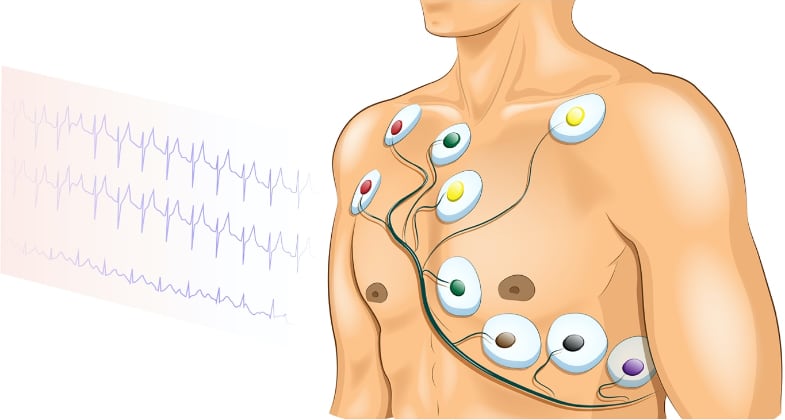
Acquiring 12-Lead ECG
During the first 10 minutes of arriving at the ED, providers monitor the patient’s vital signs and record oxygen saturation. They immediately establish intravenous (IV) access and obtain a blood sample for cardiac marker levels, electrolytes, and coagulation factors. The team completes a short but focused history and physical examination together with the fibrinolytic checklist.
Box 4: Classifying ACS Patients According to 12-Lead ECG Findings
The team leader evaluates the ECG and classifies the ACS patient into one of three groups based on the 12-lead ECG: STEMI (team proceeds to Box 5), NSTE-ACS (to Box 9), or low/intermediate-risk ACS (to Box 11).
Box 5: ST Elevation or New LBBB?
The provider identifies ST elevation or new left bundle branch block (LBBB) in the STEMI group.
By definition, ST elevation is shown in at least two contiguous leads ≥ 0.1 mV (one small box) in all leads except V2 and V3.
Box 6: Considering Adjunctive Therapies
The team ensures that any adjunctive therapies will NOT delay reperfusion.
Box 7: Determining the Onset of Symptoms
The timing will influence whether the patient is a candidate for reperfusion therapy. The magic number for reperfusion therapy is < 12 hours since the onset of symptoms. If the time from symptom onset is > 12 hours, the team proceeds to box 10.
Box 8: Defining Reperfusion Goals
Percutaneous coronary intervention (PCI) and fibrinolytic therapy are the mainstay treatments for STEMI patients within 12 hours of symptom onset. These treatments reduce the risk of mortality and morbidity. The goal is an ED door-to-balloon time of ≤ 90 minutes. If fibrinolysis is indicated instead of PCI, the goal is a door-to-needle time of ≤ 30 minutes.
Box 9: High-Risk Non-ST Elevation ACS
Ischemic ST segment depressions of > 0.05 mV (one-half small box or higher) OR T wave inversion with chest discomfort characterizes the NSTE-ACS group.
Box 10: Considering an Early Invasive Strategy
The provider considers invasive therapies for patients who are considered high risk or have elevated troponin levels. High-risk patients have hemodynamic instability, ischemic chest pain, persistent ST deviation, ventricular tachycardia, or heart failure.
The team also considers adjunctive therapies such as heparin or nitroglycerin if indicated.
Box 11: Low- or Intermediate-Risk ACS
Normal ST segments and T waves indicate a low risk for ACS.
Box 12: Considering Admission
For low- or intermediate-risk patients, the provider considers admission to the appropriate level of care for continued monitoring.
Patients presenting with STEMI require rapid triage and management to ensure the best cardiac outcomes. The other two categories—NSTE-ACS and angina—although they likely have a similar underlying etiology, require more detailed risk assessment before initiating a treatment strategy. The adverse outcomes of ACS include cardiogenic shock and death.
The important steps in managing ACS include:
- Rapid triage of patients with chest pain to determine if ischemia is present
- 12-lead ECG to evaluate for ischemia
- Patients are triaged into the three ECG categories: STEMI, NSTE-ACS, and angina.
- Acceptable STEMI and new-onset left bundle branch block (LBBB) candidates should be stratified for reperfusion. Reperfusion goals involve fibrinolytic treatment ≤ 30 minutes from symptom onset or percutaneous coronary intervention (PCI) ≤ 90 minutes from presentation at the hospital. Therapy should be provided as quickly as possible.
- Responders should be aware of the medications used to manage chest pain and improve perfusion.
- Patients with STEMI and signs of heart failure or cardiogenic shock should be cared for at a facility that is skilled at high-level cardiac management including PCI, intra-aortic balloon pumps (IABP) and coronary artery bypass graft (CABG) procedures.
Related Video: Understanding the Acute Coronary Syndrome Algorithm
The ACS Syndromes
Patients with acute coronary syndromes need early diagnosis and management to prevent long-term cardiac complications. Unfortunately, a delay in diagnosis and activation of the emergency medical team is the cause for most of the delays in management. Outside of the hospital, multiple factors can delay diagnosis. These include racial minority status, female sex, older age, low socioeconomic status (SES), and living alone. Inside the hospital, diagnosis can be delayed by atypical presentations, clinician error in diagnosis, and inefficient hospital care systems.
Related Whiteboard: Acute Coronary Syndrome – Chest Pain Suggestive of ACS
For all patients presenting with likely ACS, the initial treatment includes:
- Aspirin: patients should receive 162–325 mg of aspirin to chew unless they have already received it, have an allergy, or there is another contraindication. This can be done by family members or bystanders outside of the hospital or by responders within the ED or hospital unit.
- 12-lead ECG: this should be obtained immediately. Pre-hospital, this should be done by EMS within 10 minutes of arrival and communicated to the receiving hospital.
- Triage of STEMI patients to administer reperfusion therapy: appropriate candidates should be immediately identified and risk-stratified for reperfusion. There is evidence that administering fibrinolytics outside of the hospital improves patient outcomes and decreases death. The goal is 30 minutes (door-to-needle) for administering fibrinolytics and 90 minutes (door-to-balloon time) for angioplasty or cardiac stenting. Patients may be transferred immediately to the cardiac catheterization laboratory to reduce delay.
- The appropriate level of care: patients who will receive PCI should be transported to hospitals with this capability. If the patient needs to be transferred from one hospital to another, this should be accomplished in 30 minutes or less.
- Alternative therapies: additional therapies include clopidogrel, ticagrelor, and prasugrel as reperfusion therapy if the patient cannot be managed with fibrinolytics.
Related Video: Aspirin – ACLS Drugs
Diagnosing Chest Pain
There is a range of conditions causing chest pain. It is vital to determine which are life-threatening. ECG and clinical evaluation will help to identify STEMI patients in need of reperfusion. Noncardiac chest pain should be managed according to the etiology. Chest pain that is equivocal for cardiac origin is more challenging. Evaluation of the patient’s likelihood of a cardiac event will help to stratify their risk for cardiac causes of chest pain.
Laboratory Evaluation for ACS
Aside from the ECG, cardiac troponins are an important aspect of evaluating cardiac chest pain. A high troponin > the 99th percentile is both sensitive and specific for cardiac ischemia. Studies show that integrating troponin levels into the evaluation for ACS improves the diagnostic rate with false-negative rates between 0 and 1.2%.
However, in association with ACS algorithms like the North American Chest Pain score and Vancouver rule, a low troponin (< the 99th percentile) at under 2 hours from pain onset can determine a < 1% risk of ACS in the next 30 days. Additionally, a low troponin at under 6 hours in a patient with very low risk based on ACS algorithms determines a lower than 1% risk of ACS in the next 30 days.
Still, the 2015 ACA guidelines for CPR do not recommend these tests be used in isolation to identify patients with low risk for having ACS. Specifically, troponin alone should not be used between 0 and 2 hours from symptom onset to determine low risk for ACS. (Class III: harmful, Evidence level B-NR).
Troponins under the 99th percentile between 0 and 2 hours from the onset of symptoms can be used with other risk stratification to determine a lower than 1% risk of ACS in the next 30 days. (Class IIa, Evidence level B-NR). Negative troponins at the onset of symptoms and again at between 3–6 hours from symptom onset can be used with other risk stratification to determine a lower than 1% risk of ACS in the next 30 days. (Class IIa, Evidence level B-NR).
The Range of ACS
The underlying etiology of ACS is atherosclerosis or accumulated lipids and oxidation byproducts in the arterial endothelium. These accumulated deposits form plaques that can occur in the coronary arteries, leading to coronary artery disease (atherosclerosis). While this process usually takes decades to occur, once the lumen of the arteries narrows to a certain extent, patients will develop symptoms with exertion. Additionally, a small disruption in the plaque can lead to intermittent mild symptoms termed angina pectoris. A large disruption can cause one of the three categories of ACS to occur. A very large event can lead to sudden death and may even be the only symptom of the disease.
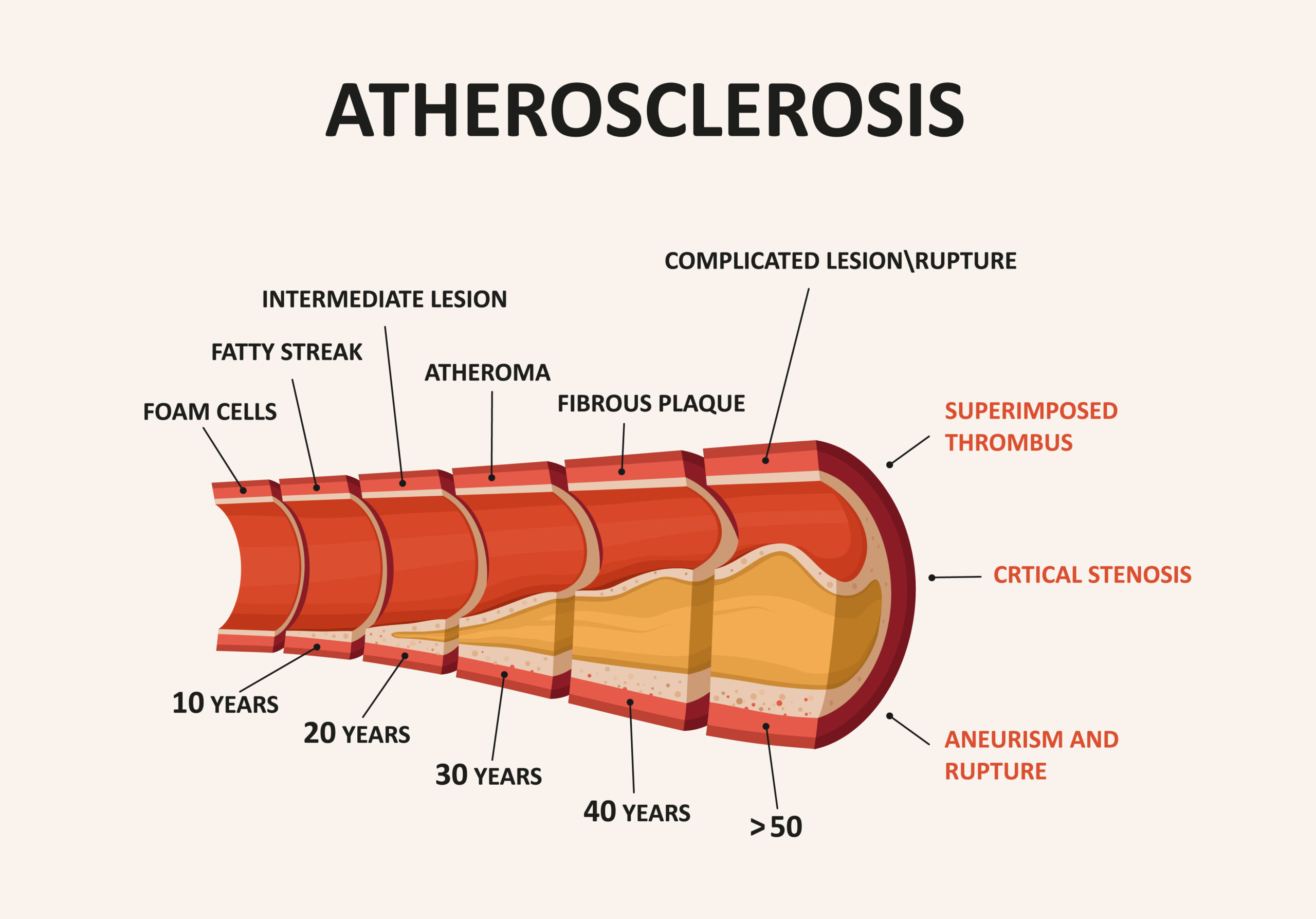
Atherosclerosis Timeline
Angina Pectoris
This can be a symptom of the slow progression of atherosclerotic plaques in the coronary arteries. The patient will complain of central chest pain that feels like pressure, squeezing, or tight. Some patients will have pain going to the arm or neck.
Typically, patients will have pain with exertion or stress, and this will resolve after rest or with nitroglycerin. Unlike angina pectoris, ACS can occur without any significant exertion as ACS patients usually have more severe disease.
ECG findings of ACS
As noted above, any patient with a concern for ACS will need an emergent ECG, as this will help with diagnosing and triaging the disease. The three categories noted above are:
- STEMI: ECG findings will reveal ST elevation in two or more leads or a new LBBB. The ST elevation depends on sex and age.
- For men ≥ 40 year: ST should be elevated at least 0.2 mm in leads V1 and V2.
- For men < 40 years: ST should be elevated at least 0.25 mm in leads V2 and V2.
- For women: ST should be elevated at least 0.15 mm for leads V1 and V2.
- For all patients: ST elevation should be at least 0.1 mm (or 0.1 mv) in all other leads.
- Non-STEMI: ECG findings will reveal a depression of at least 0.5 mm in the ST segment. There may also be T wave inversions. These findings may last for under 20 minutes. Depression is 0.5 mm in leads V2 and V3, and 1 mm in other leads for all patients.
- Angina: These symptomatic patients may have a normal ECG or findings apart from the diagnostic ST changes or T wave inversions noted above. For example, patients may have ST deviations less than 0.5 mm. These patients can be further categorized based on troponin levels.
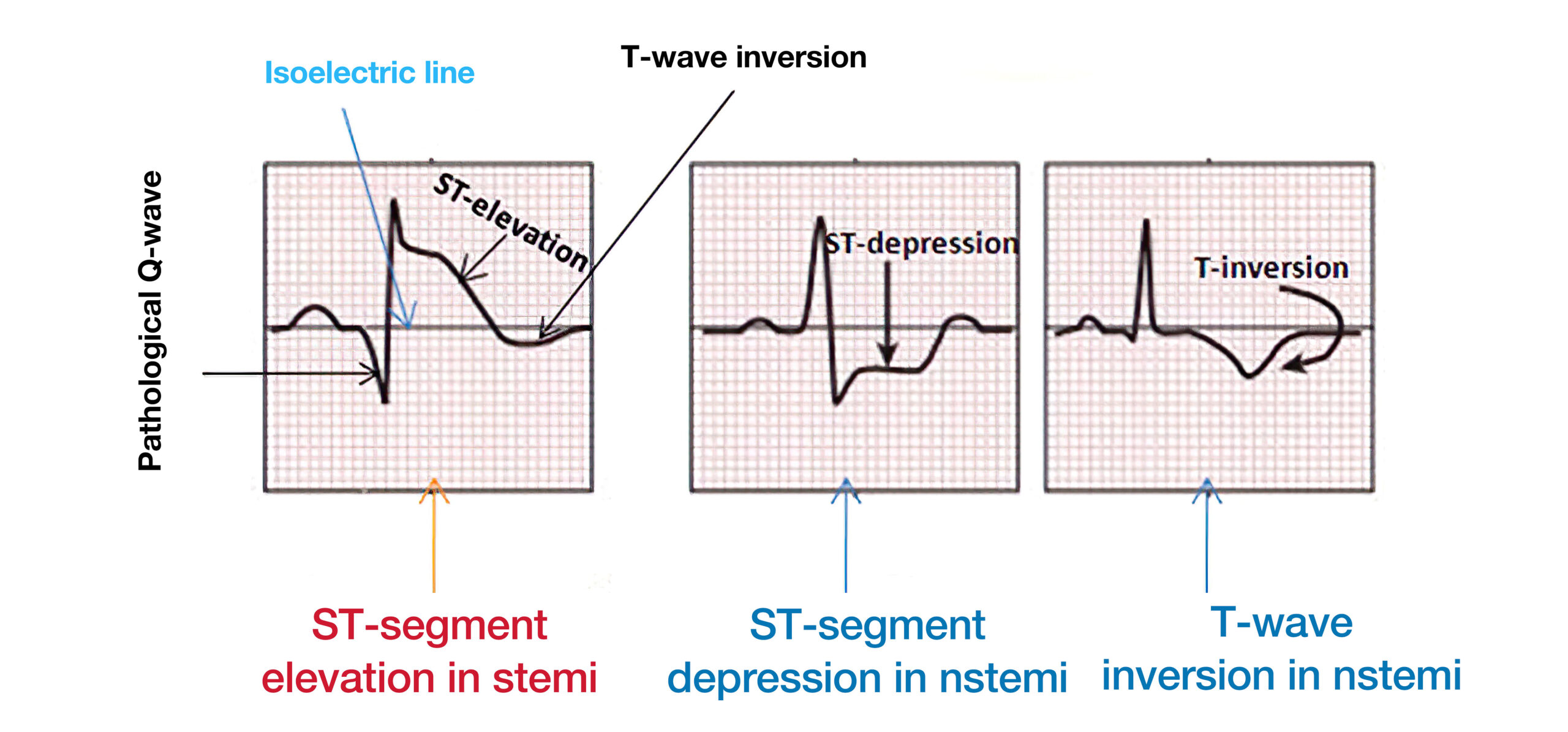
ECG Changes in ACS

Acute Coronary Syndrome ECG Changes
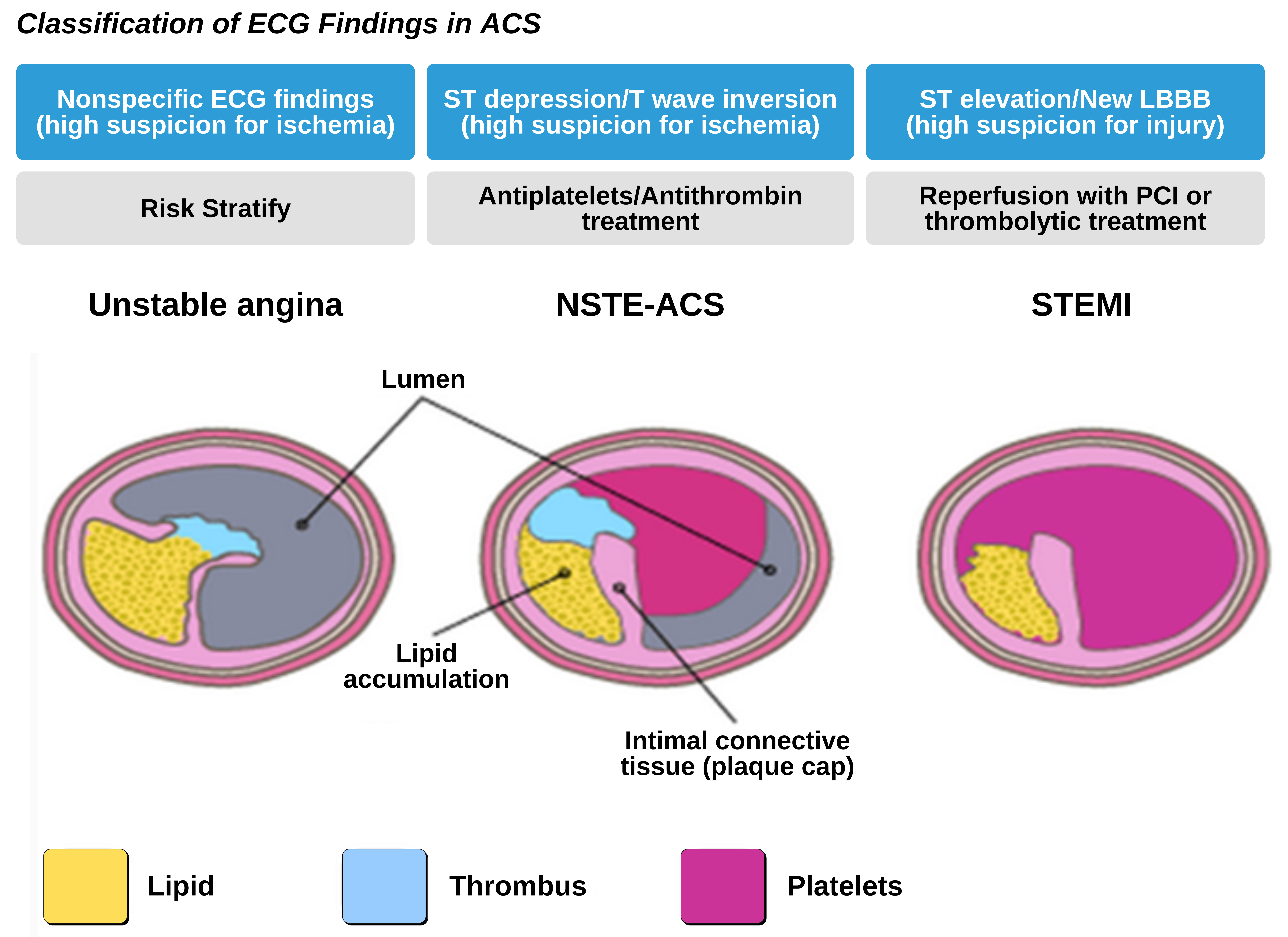
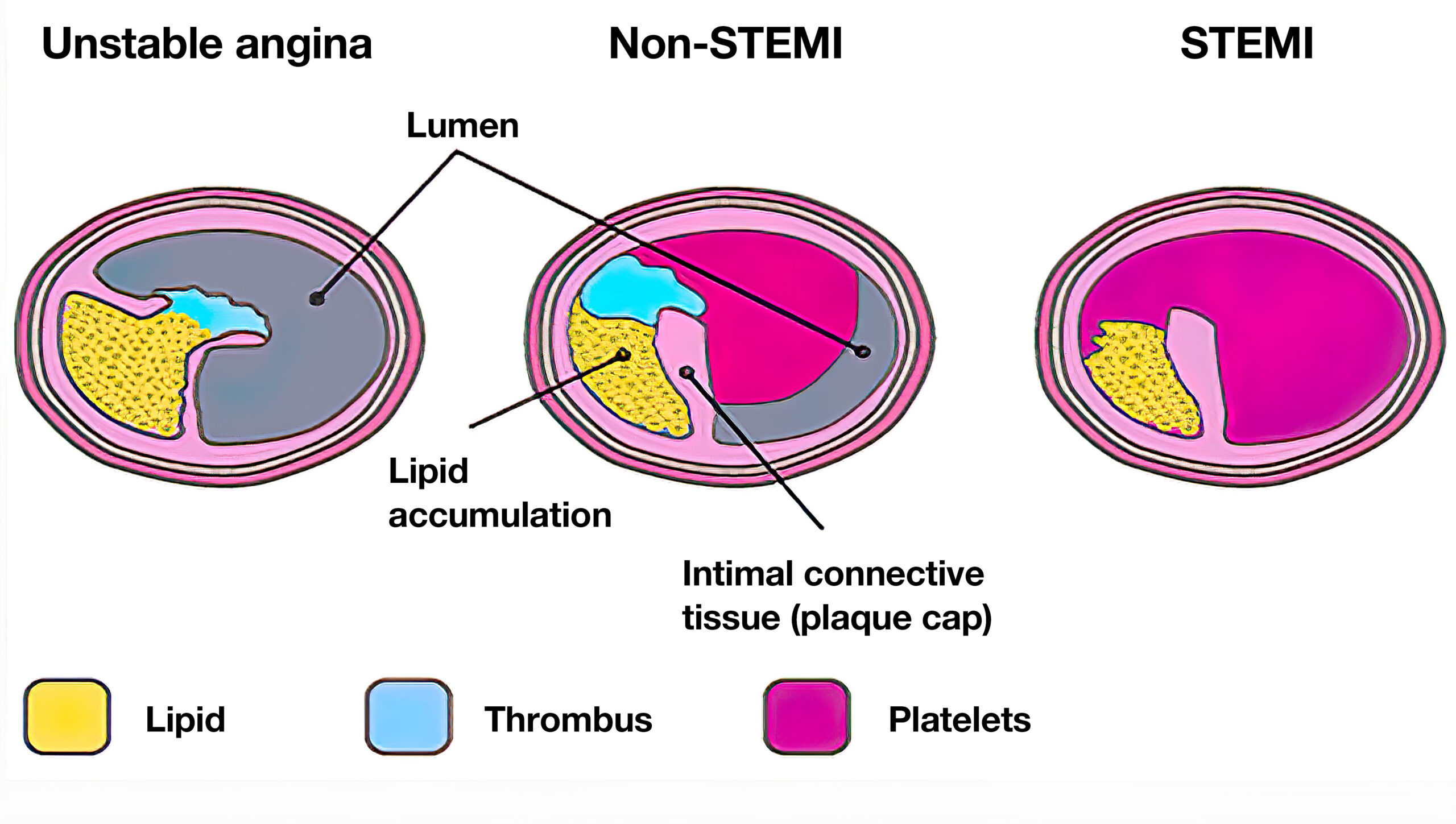
ECG findings determine ACS treatment strategy.
When STEMI is found on ECG, reperfusion is the next step, assuming there are no contraindications.
On the other hand, NSTE-ACS should not be managed with fibrinolytic therapy, as this is associated with worse outcomes and increased mortality. Instead, these patients should have antiplatelet and antithrombin medications administered. A caveat to this is that patients with a posterior MI should receive standard STEMI treatment.
Of the patients presenting with angina (nonspecific or normal ECG findings), many will not have true ACS. These patients should be triaged based on their risk, using clinical factors and algorithms.
All ACS patients should receive aspirin as long as they do not have allergies or other contraindications.
Key Takeaway
12-lead ECG is used to diagnose and triage ACS and is central to management.
The ECG should be obtained rapidly—within 10 minutes of ED presentation—if not already done outside of the hospital or in the inpatient unit.